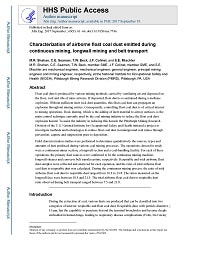Mining Publication: Characterization of Airborne Float Coal Dust Emitted During Continuous Mining, Longwall Mining, and Belt Transport
Original creation date: September 2017
Authors: MR Shahan, CE Seaman, TW Beck, JF Colinet, SE Mischler
Float coal dust is produced by various mining methods, carried by ventilating air and deposited on the floor, roof and ribs of mine airways. If deposited, float dust is re-entrained during a methane explosion. Without sufficient inert rock dust quantities, this float coal dust can propagate an explosion throughout mining entries. Consequently, controlling float coal dust is of critical interest to mining operations. Rock dusting, which is the adding of inert material to airway surfaces, is the main control technique currently used by the coal mining industry to reduce the float coal dust explosion hazard. To assist the industry in reducing this hazard, the Pittsburgh Mining Research Division of the U.S. National Institute for Occupational Safety and Health initiated a project to investigate methods and technologies to reduce float coal dust in underground coal mines through prevention, capture and suppression prior to deposition.
Field characterization studies were performed to determine quantitatively the sources, types and amounts of dust produced during various coal mining processes. The operations chosen for study were a continuous miner section, a longwall section and a coal-handling facility. For each of these operations, the primary dust sources were confirmed to be the continuous mining machine, longwall shearer and conveyor belt transfer points, respectively. Respirable and total airborne float dust samples were collected and analyzed for each operation, and the ratio of total airborne float coal dust to respirable dust was calculated. During the continuous mining process, the ratio of total airborne float coal dust to respirable dust ranged from 10.3 to 13.8. The ratios measured on the longwall face were between 18.5 and 21.5. The total airborne float coal dust to respirable dust ratio observed during belt transport ranged between 7.5 and 21.8.

- Benchmarking Longwall Dust Control Technology and Practices
- A Centennial of Mine Explosion Prevention Research
- Control of Respirable Dust
- Controlling Dust Exposures in Longwall Mining Utilizing A Simple Barrier
- Evaluation of the Approach to Respirable Quartz Exposure Control in U.S. Coal Mines
- The Explosibility of Coal Dust
- Open-air Sprays for Capturing and Controlling Airborne Float Coal Dust on Longwall Faces
- Status of a Tapered Element, Oscillation Microbalance-Based Continuous Respirable Coal Mine Dust Monitor
- Suggestion of a Cause-and-Effect Relationship Among Coal Rank, Airborne Dust, and Incidence of Workers' Pneumoconiosis
- Technology News 515 - Float Coal Dust Explosion Hazards